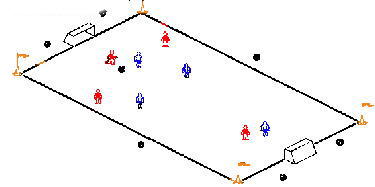
This program was put together by Jeff Pill and Dave Simeon. Jeff is the NHSA Director of Coaching and a National Staff Coach with US Soccer. Dave is the North Texas Director of Coaching and is also a National Staff Coach with US Soccer.
I. Some Basics For 4 v. 4
The prority in 4 v. 4 is to motivate players in an environment that is condcive to learning. The more pleasure kids derive from their participation, the more they wish to play and practice on their own. While their instinct to play is natural, their affection and appreciation for soccer must be cultivated. The 4 v. 4 game is foundational to such goals because it:
What About The Goalkeeper?
Goalkeeping, as it relates to the adult version of soccer, requires a combination of skill, athleticism, and decision making. A goalkeeper is not used in the 4 v. 4 game because:
II. Why 4 v. 4?
The mode and method for children's play has changed substantially. The sandlot and playgrounds which allowed for free play have been replaced by organized sport associations and leagues which are instead governed by adults. As a result, these leagues reflect what adults believe the game of soccer should be like for youngsters. The by-product of this is often overcoaching and the investing of an abundance of money ×ÿd resources on uniforms. warm-ups, and equipment. There is always the likelihood that parents and coaches become too involved in the game during "the game".
Teaching soccer to children requires that the information provided to them is appropritae for their maturity level through some means (THE GAME) that makes sense to them. The environment for play must, essentially, meet the needs of players.
Reducing the number of players to 4 per team allows for all of the components that are present in the 11 v. 11 game: the ball, teammates and opponents, realistic pressure, apropriate space, guidelines (rules), direction of play (attacking and defending), and the combination of length and width in the game (team shape).
What Is Developed
Skill that is realistic. Motor ability: balance, agility, and coordination. Perception: insight and awareness. Vision. Problem solving: choices and decisions. Physical fitness. Psychological domain: fun, enjoyment, and competition. Learning by discovery, trial and error, playing!!!
Repetition
This is perhaps the single most inportant aspect over the long term process of debeloping soccer playing ability. On the playgrounds and sandlots, this occurs naturally... No lines, no waiting, participation is maximized.
Youngsters recognize differing situations that are constantly repeated. Repetition influences: Skill required to play the game (dribbling, passing, shooting, etc.). Decisions and choices that occur during the game.
III. The Role of the Youth Coach
In 4 v. 4 soccer, the role of the coach is that of facilitator. The coach sets up the game and the conditions for learning, provides some supervision and allows the game to teach. The coach becomes a manager of the games with the comprehensive and long range objective being to develop and improve the soccer performance of the players.
The primary objective for youth players under 11 years of age is the development of technical skill. This is due, in part, to the nature of youngsters and their willingness to experiment to find their own way to execute technical skill.
Another contributing factor for am emphasis on skill development is that skill is considered a shortcoming. Remember, technique is not an objective in and of itself but a tool. Technical skill must always have a relationship with the game (application). Problem solving, decision making, intuition, anticipation, and technical skill must be developed in the context of games.
Technical activities, outside of games, should not be considered the "end all and be all". The game, and involvement of playing the game, is most important. Too often, these activities on the individual basis are "drills" and are not realistic as far as the demands of the game are concerned. Technical skills should not be viewed as "tricks" or "gimmicks", but in the end, must be practical to use in the game.
Considerations On How the Youth Soccer Coach Can Influence Players
Coaches need to insure that the playing/practice environment is conducive for development and performance and is favorable for learning to take place. They also need to ensure that the three main areas of the game occur in this environment.
The 4 v. 4 game allows youth coaches to become familiar with the three main areas of the game.
The 4 v. 4 game provides a much clearer environment to analyze the match and its individual components and is therefore not as intimidating to beginning coaches. The coach can observe:
Youth soccer coaches contribute to player development by:
While technique, decision making and physical talent can be distinguished from one another, they are not related.
IV. The Basic Game and Variations

Size of Field
Depends on the age of players. Can vary from 30 yd. x 20 yd. up to 40 yd. x 25 yd.. The goals are 8 feet wide.
The Team In Possession of the Ball
When the Other Team Has the Ball
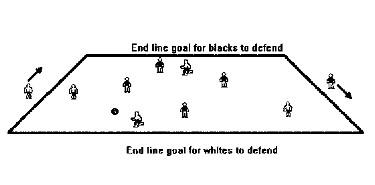
Variations of the 4 v. 4 Game
Using slightly different sizes of goals, differing methods to score, and slightly altered size and shape of field can guide players to solve problems by emphasizing certain aspects of play.
4 v. 4 Line Soccer
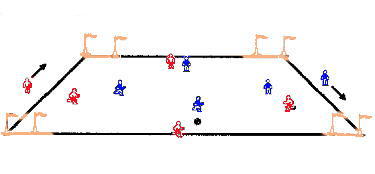
The Game
Same field as the "Line Soccer" game, a wide, short field. teams can score in one of 2 ways. Passing into an open goal or by stopping the ball on the endline between the two goals they are attacking.
What The Game Incorporates
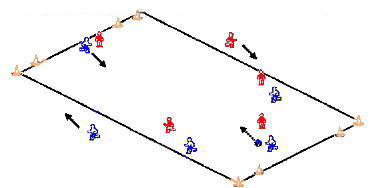
The Game
Since the playing area is longer than it is wide, the emphasis is on creating length (height) in the game. In this game, there is a premium placed on playing the ball forward early. The ball can be played early:
Scoring
This Game Emphasizes
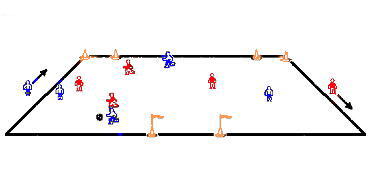
The Game
While one team attacks the large goal, the opposition attacks either of the two smaller goals. When the team scores in one of the two smaller goals, they must change directions and take a turn at attacking the larger goal.
This Game Emphasizes
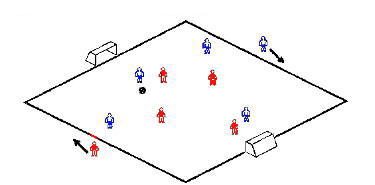
The priority of this game is shooting and scoring. Since the field is wide and short, players should be looking to shoot almost whenever they get the ball. Game played like a regular 4 v. 4 match.
ROSTERING AND COMPETITION: The Weekly Tournament
Rostering Rostering youngsters enables association or league organizers to acquire name, address, phone number, correct birthdate and parental consent. This information is then used to obtain the required insurance for each player. At this level of play, rostering serves on the purposes of player registration and insurance.
The group of players who are rostered together are considered, in very broad terms, a "team". Although they are rostered to the same "team" the groups of 4 will change from practice to practice and game to game. The number of players on each team will be determined by the way your league or association organizes the playing structure of the weekly competition. Let's look at 2 examples:
As can be seen. rostering has some flexibility depending on hoew a league or team organizes the weeklt tournament. Players rostered to these "teams" also share a weekly practice time, The team would then spend this time with one or more youth coaches.
Basic Rules For The 4 v. 4 Game
Part of the effectiveness of modifying the game to 4 v. 4 is also modifying the rules. These rule changes contribute to 4 v. 4 meeting the develpomental needs of young players. The adult version of soccer includes adult oriented rules suitable for adult understanding , behaviour, ability, and competition. The basic rules are:
Schedule For 48 Players & 6 Fields
3 teams of 16 players divided into 4 groups of 4 players each.
Each team plays a balanced schedule of 5 games and has 2 consecutive games on the same field at one point during the tournament.
Schedule For 48 Players & 6 Fields
>
| Competition Assignments | |
|---|---|
| Team A plays: J, H, E, F, I | Team G plays: B, J, L, C, K |
| Team B plays: G, L, I, K, H | Team H plays: D, A, J, L, B |
| Team C plays: I, E, K, G, F | Team I plays: C, F, B, E, A |
| Team D plays: H, K, F, J, L | Team J plays: A, G, H, D, E |
| Team E plays: K, C, A, I, J | Team K plays: E, D, C, B, G |
| Team F plays: L, I, D, A, C | Team L plays: F, B, G, H, D |
Schedule For 48 Players & 5 Fields
3 teams of 16 players divided into 4 groups of 4 players each.
As 5 fields are not sufficient to accomodate continuous play for each group, 2 groups must sit out for each time slot. The groups scheduled to play on the 6th field are now designated "rest" or "idle" teams. A completely balanced schedule is not possible as there are 2 groups whixh play 5 games while the remaining 10 groups play only 4 games. For this reason, it is recommended that the allocation of teams (16 players) to letter groups is rotated on a weekly basis.
Schedule For 48 Players & 5 Fields
>
| Competition Assignments | |
|---|---|
| Team A plays: J, H, E, I | Team G plays: B, J, C, K |
| Team B plays: G, L, I, K, H | Team H plays: D, A, J, L, B |
| Team C plays: E, K, G, F | Team I plays: F, B, E, A |
| Team D plays: H, F, J, L | Team J plays: A, G, H, D,/th> |
| Team E plays: K, C, A, I, | Team K plays: E, C, B, G |
| Team F plays: L, I, D, C | Team L plays: F, B, H, D |
Schedule For 44 Players & 5 Fields
2 teams of 16 players and 1 team of 12 players divided into 4 groups of 4 players each.
As 5 fields are not sufficient to accommodate continuous play for each group, 1 group must sit out for each time slot. The groups scheduled to play on the 6th field are now designated "rest" or "idle" teams. A completely balanced schedule is not possible as there are 2 groups which play 5 games while the remaining 5 groups play only 4 games. For this reason, it is recommended that the allocation of teams (16 players) to letter groups is rotated on a weekly basis.
Schedule For 44 Players & 5 Fields
>
| Competition Assignments | |
|---|---|
| Team A plays: E, F, J, G, I | Team G plays: I, J, A, B |
| Team B plays: J, K, F, H, G | Team H plays: D, I, C, B |
| Team C plays: E, H, I, F | Team I plays: G, H, E, C, A |
| Team D plays: H, K, E, J, | Team J plays: B, G, A, F, D |
| Team E plays: A, C, I, D, K | Team K plays: F, B, D, E |
| Team F plays: K, A, B, J, C | |
Schedule For 40 Players & 5 Fields
1 team of 16 players and 2 teams of 12 players divided into groups of 4 players each.
Each team plays a balanced schedule of 5 games and has 2 consecutive games on the same field at one point during the tournament.
Schedule For 40 Players & 5 Fields
>
| Competition Assignments | |
|---|---|
| Team A plays: G, I, F, H, E | Team G plays: A, C, D, B, J |
| Team B plays: J, E, H, G, I | Team H plays: E, F, B, A, C |
| Team C plays: F, G, J, I, H | Team I plays: D, A, E, C, B |
| Team D plays: I, J, G, E, F | Team J plays: B, D, C, F, G |
| Team E plays: H, B, I, D, A | |
| Team F plays: C, H, A, J, D | |
Schedule For 36 Players & 4 Fields
3 teams of 16 players divided into 4 groups of 4 players each.
Each team plays either 4 or 5 games and has 2 consecutive games on the same field at one point during the tournament.
Schedule For 40 Players & 5 Fields
>
| Competition Assignments | |
|---|---|
| Team A plays: D, E, F, H, G | Team G plays: B, C, E, D, A |
| Team B plays: G, D, I, E, H | Team H plays: C, F, A, B, |
| Team C plays: H, G, D, F | Team I plays: E, B, F, D |
| Team D plays: A, B, C, G, I | |
| Team E plays: I, A, G, B | |
| Team F plays: H, A, I, C, | |